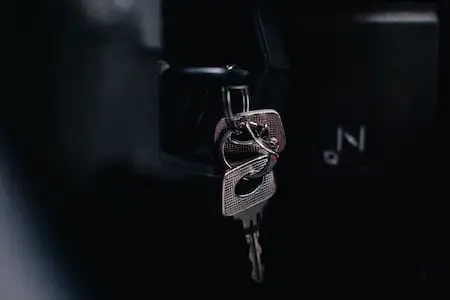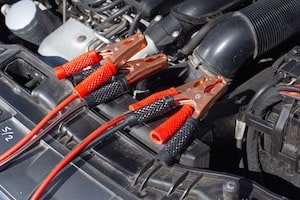We’ve all been where you are now. You climbed into your car to head somewhere important and the car won’t start! It always seems to happen at the worst time doesn’t it. Not to worry, I will get you right to the point and cover the most important things that you need to know to get your car started and diagnose the rapid clicking and save you money and time.
When a car battery is very low there will be no rrr-rrr-rrrr sound of the engine turning over but only rapid clicking.
Rapid clicking noises when trying to start a car means the battery has too little stored energy to fully engage the starter motor, or has a poor connection restricting the current flow of the battery. This can indicate the battery needs to be replaced but there can also be other issues that drained the battery.
What causes the rapid clicking noise when I try to start my car?
The rapid clicking sound you hear when trying to start a car is caused by the starter solenoid opening and closing rapidly because there is not enough current to keep the solenoid engaged and not enough current to get the starter motor gears to turn over the engine.
How do you determine then what the problem is that caused the battery to drain? By trial and error unfortunately but this is exactly what a mechanic shop is going to do. I know because I’ve worked as a mechanic. The shop is going to test one thing at a time until they find the solution. Not to worry, there are only 3 simple things to check to determine the problem in this situation.

Three Things to Check When Rapid clicking but not Cranking
First, Check the Battery
Place a charger on it or simply replace the battery and try starting the car.
Swap in a battery from another car and see if it starts. Most car batteries are compatible.
A battery is very easy to change. The Drive has done a very nice job completely answering any questions you may have if you are unsure how to replace a battery. Read their comprehensive article How to Change a Car Battery.
Or jump start your car. If it jump starts right away then the battery was low, but has it gone bad or could it be the alternator?
One of the first things I do to determine if my battery has gone bad is look at the sticker on the battery indicating the date that the battery was assembled. Often it is a round and colored sticker with numbers like 05/20. If your battery is more than 5 years old I would suspect that it has gone bad, and should be replaced.
This is a key indicator of how likely it is that your battery is the problem and is not certain. Take your battery in to be checked for free at an auto shop. Stores like Autozone will check and even charge your battery for free.
To learn how to check the battery and alternator yourself keep reading!
Second, Check Battery Connections
Poor battery connections can cause all sorts of problems one of them being that your car will not start. Even when the battery is fully charged. A loose or corroded battery terminal connection can cause enough resistance to limit the current flow from the battery resulting in your car not starting.
Inspect the battery terminals.
It is a good idea to unbolt the battery terminals, clean, and replace them.
Pro Tip: Only loosen the terminal enough to rotate and remove it. The terminals are tapered and as you reinstall the cable, rotate slightly as you push down for a secure connection.
A poor ground connection is commonly the problem. Follow the negative battery terminal to the chassis or the engine block where it is grounded and ensure that it is a clean and tight connection.
Third, Check the Alternator
Just because the battery was low or dead does not mean it was the root cause of the problem
The next culprit to check is the alternator. The alternator is what charges the battery and when the alternator fails (which it does due to normal wear) your battery is not being charged while the engine runs and no matter if the battery is new, it will eventually drain.
How long does an alternator last?
An alternator generally lasts 80,000 miles according to mechanics and manufacturers say you should expect 100,000 to 150,000 miles out of an alternator. Performing an alternator swap at 100,000 miles before it goes bad is highly recommended.
Check the alternator by driving into a shop or parts store and have them check it for free or learn to do it yourself.
Measure the voltage of the battery while the car is running to determine if the alternator is the cause of your battery dying.
How do I Determine that my Alternator is Bad?
Use a multimeter. Follow the link to order one on Amazon. I recommend this multimeter because I personally own this meter and Klein is a good name brand. Always go with a tool that will last a long time like this multimeter. It will last for years to come.
Measure the voltage of the battery with the car off. The battery is good when the voltage is between 12.4-12.9 volts. If the voltage is outside of this threshold then the battery should be replaced.
Turn the car on, and measure the voltage of the battery while it is running. While the car is running the voltage should be between 13.5-14.5 volts. If the voltage is outside of this threshold then your alternator should be replaced.
What Does it Mean if I Only Hear a Single Click When Starting My Car?
When your battery is sufficiently charged, if you listen closely as you turn the key – or push the start button – you will hear a single click just before the starter gears fully engage with the gear on the engine, and the car’s engine begins rotating and starting-up. This single click is the solenoid switching positions.
This single click is also heard when the car won’t start and the only difference is it is not followed by the starter turning the engine. A single click when starting a car means the same as rapid clicking. It is caused by insufficient battery power.
If you hear one single click it is the solenoid switching positions to allow electricity flow to the starter but insufficient power in the battery to turn the starter motor and only enough to flip the solenoid. Charge or replace your battery or jump start the car.


